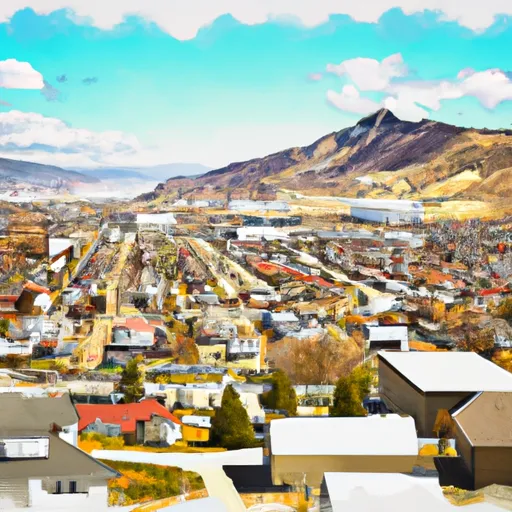-
 Snoflo Premium
Snoflo Premium
Get unlimited access to all our content
With no Ad interruptions! - Start Your Free Trial Login with existing account
Joseph
Eden Index
Climate
8.4
•
Recreation
2.5
•
Community
•
Safeguard
4.2/10

Joseph, Utah is a small town located in the northeastern part of the state. The climate in Joseph is characterized by cold winters and warm summers. The average high temperature in the summer months is around 85°F, while the average low temperature in the winter drops to about 20°F. The town experiences moderate precipitation throughout the year, with the majority of it falling as snow during the winter.
Hydrologically, Joseph is surrounded by several water bodies, including Bear Lake and the Logan River. Bear Lake, located just north of town, offers a range of recreational activities such as boating, fishing, and swimming. The Logan River, which runs through the nearby Logan Canyon, provides ample opportunities for fly fishing and rafting.
In addition to water-based activities, Joseph boasts a variety of outdoor recreation opportunities. The surrounding mountains and forests provide ample opportunities for hiking, camping, and wildlife viewing. The nearby Beaver Mountain Ski Resort offers skiing and snowboarding in the winter, and the area is also popular for snowmobiling and cross-country skiing.
Overall, Joseph, Utah offers a picturesque setting with a diverse range of outdoor recreation opportunities, making it an ideal destination for nature enthusiasts and adventure seekers.
What is the Eden Index?
The Snoflo Eden Index serves as a comprehensive rating system for regions, evaluating their desirability through a holistic assessment of climate health, outdoor recreation opportunities, and natural disaster risk, acknowledging the profound impact of these factors on livability and well-being.
Climate Health Indicator (CHI): 8.4
Joseph receives approximately
229mm of rain per year,
with humidity levels near 60%
and air temperatures averaging around
10°C.
Joseph has a plant hardyness factor of
6, meaning
plants and agriculture in this region thrive during a short period during spring and early summer. Most
plants will die off during the colder winter months.
By considering the ideal temperature range, reliable water supplies, clean air, and stable seasonal rain or snowpacks, the Climate Health Indicator (CHI) underscores the significance of a healthy climate as the foundation for quality living.
A healthy climate is paramount for ensuring a high quality of life and livability in a region, fostering both physical well-being and environmental harmony. This can be characterized by ideal temperatures, reliable access to water supplies, clean air, and consistent seasonal rain or snowpacks.
Weather Forecast
Streamflow Conditions
Escalante Desert-Sevier Lake
Area Rivers
Escalante Desert-Sevier Lake
Snowpack Depths
Escalante Desert-Sevier Lake
Reservoir Storage Capacity
Escalante Desert-Sevier Lake
Groundwater Levels
Recreational Opportunity Index (ROI): 2.5
The Recreational Opportunity Index (ROI) recognizes the value of outdoor recreational options, such as parks, hiking trails, camping sites, and fishing spots, while acknowledging that climate plays a pivotal role in ensuring the comfort and consistency of these experiences.
Access to outdoor recreational opportunities, encompassing activities such as parks, hiking, camping, and fishing, is crucial for overall well-being, and the climate plays a pivotal role in enabling and enhancing these experiences, ensuring that individuals can engage in nature-based activities comfortably and consistently.
Camping Areas
| Campground | Campsites | Reservations | Toilets | Showers | Elevation |
|---|---|---|---|---|---|
| Lebaron Rec Site | 14 | 10,049 ft | |||
| Piute State Park | None | 5,987 ft | |||
| Maple Hollow | 10 | 7,000 ft | |||
| City Creek | 5 | 7,520 ft | |||
| Three Creeks Reservoir Dispersed | None | 8,696 ft | |||
| Anderson Meadow | 10 | 9,451 ft |
Nearby Ski Areas
Catastrophe Safeguard Index (CSI):
The Catastrophe Safeguard Index (CSI) recognizes that natural disaster risk, encompassing floods, fires, hurricanes, and tornadoes, can drastically affect safety and the overall appeal of an area.
The level of natural disaster risk in a region significantly affects safety and the overall livability, with climate change amplifying these risks by potentially increasing the frequency and intensity of events like floods, fires, hurricanes, and tornadoes, thereby posing substantial challenges to community resilience and well-being.
Community Resilience Indicator (CRI):
The Community Resilience Indicator (CRI) recognizes that education, healthcare, and socioeconomics are crucial to the well-being of a region. The CRI acknowledges the profound impact of these elements on residents' overall quality of life. By evaluating educational resources, healthcare accessibility, and economic inclusivity, the index captures the essential aspects that contribute to a thriving community, fostering resident satisfaction, equity, and social cohesion.

